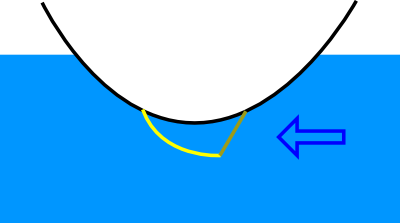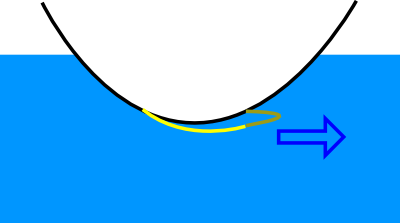Welcome to Dinas Dwr

I am trying to figure out how to make a city floating on the surface of the ocean. The above image illustrates the best way I have figured out to do it so far. The essential feature is the alternating posts and gaps around the perimeter of a roughly circular flotation mass.
The trick is to allow the entire thing to be modular, diverse, and flexible. It should be modular so that individual components can be added or removed easily. If the city is designed as non-modular, adding or removing one piece would require patching holes, welding, cutting, glue, and all that difficult stuff. It should be diverse so that you can have many different styles of modules hooked together into one city. If all the modules have to have the same shape, what happens when someone comes up with a better interface style, or a better geometry? You have to start a whole new float, that's what! It should be flexible because the surface of the ocean moves! If it is non-flexible, huge forces must be accounted for (like those that break large ships in half!).
So, what's my idea? Connect all your modules together using rope (line, cable, something flexible that resists tension). The modules can be held (both together and apart) flexibly without touching. The force on the lines will be less than that on hinges or welds, since the stretch works in your favor (spreading out shocks and sudden impulses). It also allows a large variety of interfaces to be connected, as long as the general pole and gap design is honored. In this way, a very low budget startup sea colony can get going, expand to a large size, be modular, and easy to maintain and update.
The other great advantage of this concept is that you have the possibility of implementing something I call a wavedrive (I'm sure there's something else called "wave drive" out there, but humor me for a moment). It essentially takes advantage of the forward-backward movement of the waves to drive a large wave-following structure with or against the waves. Just put a flap of cloth or something hanging off the bottom of the modules, and attached in one direction. If it catches the water going one way

and lets the water pass going the other way

you have a wavedrive. Oh, and the whole thing needs to span at least a half wavelength, like so:

So that at least some part is "latched" at all times. Simple, easy to make, and effective. I've tested it! It works! This would only drive the city slowly (less than the wave propagation velocity) but when you're moving a whole city for stationkeeping, you don't need to go very fast. Also, the image shows it moving in the direction of wave propagation, but it would work just as well moving against wave propagation, due to the cycloidal nature of wave motion.
Most ocean city concepts start with the assumption that you must have a rigidly connected horizontal surface, and I just don't think that is true. I've been connected with the guys at the Seasteading institute but I think the monolithic, large, wave-clearing design they favor will be too expensive to bootstrap. All the other ideas I've seen require this kind of thinking. I say, why put a hard slab on the soft surface of the sea?
There are a lot of questions still to be answered. However, I think this interface concept will allow the freedom to connect (and disconnect) individual modules easily enough for people to decide for themselves what they want to try. Maybe it's crazy. Who knows. Thanks for taking the time to read all this rambling!
Links back to my other sites:
Peripheral Arbor, my personal website.
Wise Wizards, my blog.
Dudecon Twitter, my twitter feed.
Project Fledgeling, a "video game" sandbox I'm thinking about.



